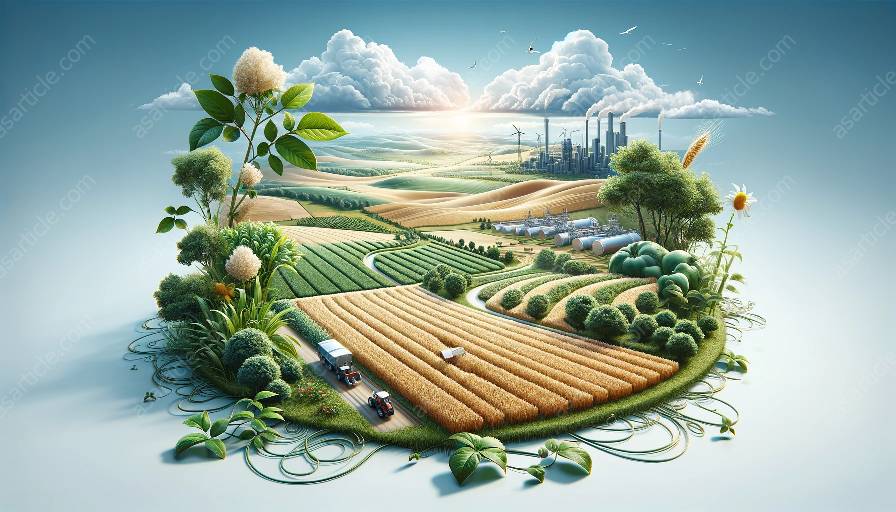Aquatic farming, or aquaculture, is a critical component of agricultural sciences that utilizes biochemistry to understand the processes and dynamics involved in the cultivation of aquatic organisms. From nutrient metabolism to molecular processes, the biochemistry of aquatic farming is a fascinating and essential topic that interconnects with agricultural biochemistry in various ways.
The Nutrient Dynamics in Aquatic Farming
One of the fundamental aspects of the biochemistry of aquatic farming is the understanding of nutrient dynamics within aquatic ecosystems. Aquatic organisms require a range of essential nutrients, including proteins, lipids, carbohydrates, vitamins, and minerals, to support growth, reproduction, and overall metabolic functions. The interplay of these nutrients in aquatic environments involves complex biochemistry, including nutrient uptake, utilization, and excretion.
For example, nitrogen and phosphorus are crucial nutrients in aquatic farming, as they are essential for the growth of organisms such as fish and crustaceans. Biochemical processes, such as nitrogen metabolism and phosphorus cycling, play a pivotal role in maintaining the nutrient balance within aquatic systems. Understanding the biochemistry of nutrient dynamics is vital for optimizing feed formulations, managing water quality, and ensuring sustainable aquaculture practices.
Molecular Processes in Aquatic Organisms
At the molecular level, the biochemistry of aquatic farming involves intricate processes that influence the growth, development, and physiology of aquatic organisms. From the metabolism of macronutrients to the synthesis of bioactive compounds, molecular biochemistry governs the intricate pathways within aquatic organisms.
For instance, lipid metabolism is a critical area of study in aquatic farming, as lipids serve as energy reserves and structural components in many aquatic species. The biochemistry of lipid metabolism encompasses processes such as lipogenesis, lipolysis, and the biosynthesis of essential fatty acids. Understanding these molecular processes is essential for formulating diets that promote optimal growth and health in aquaculture species.
Moreover, the biochemistry of aquatic farming delves into the molecular mechanisms underlying stress responses, immune functions, and reproductive processes in aquatic organisms. These aspects are crucial for maintaining the well-being and resilience of farmed aquatic species, and they rely heavily on biochemical pathways and signaling molecules.
Interconnections with Agricultural Biochemistry
The biochemistry of aquatic farming is closely intertwined with agricultural biochemistry, as both disciplines share common principles and applications. Agricultural biochemistry, which focuses on the chemical processes and molecules involved in plant and crop production, shares several parallels with aquatic farming biochemistry.
One key aspect of this interconnection is the study of nutrient utilization and metabolism in both terrestrial and aquatic systems. Agricultural biochemistry explores nutrient uptake and utilization in plants, while aquatic farming biochemistry investigates similar processes in aquatic organisms. Understanding nutrient dynamics in both contexts allows for a holistic approach to nutrient management and sustainable agriculture.
Furthermore, the molecular processes underlying plant growth and development studied in agricultural biochemistry often find parallels in the molecular biochemistry of aquatic organisms. Both disciplines delve into the intricate metabolic pathways, gene expression patterns, and biochemical regulations that influence the productivity and quality of agricultural products.
Innovations and Sustainable Practices
The biochemistry of aquatic farming drives innovations and sustainable practices in aquaculture, contributing to the advancement of agricultural sciences. Through biochemistry-driven research and technology, aquaculture practitioners and researchers can develop novel feed formulations, biosecure aquaculture systems, and environmentally friendly approaches to disease management.
For example, the application of biochemistry in optimizing feed formulations has led to the development of tailored diets that promote better nutrient utilization, growth efficiency, and immune function in farmed aquatic species. Additionally, the use of biochemical markers and molecular techniques has enhanced the monitoring of aquatic organism health and welfare, leading to improved disease management strategies in aquaculture operations.
Moreover, the integration of biochemistry into the design of sustainable aquaculture systems has enabled the development of recirculating aquaculture systems (RAS) and aquaponics, which maximize resource utilization and minimize environmental impacts. These innovative practices showcase the pivotal role of biochemistry in shaping the future of aquatic farming and its impact on agricultural sciences.
Conclusion
The biochemistry of aquatic farming plays a crucial role in shaping the practices and innovations within agricultural sciences. From understanding nutrient dynamics to unraveling molecular processes, the intricate interplay of biochemistry in aquaculture offers valuable insights for sustainable and efficient production of aquatic organisms. By exploring the connections between aquatic farming biochemistry and agricultural biochemistry, the potential for collaborative advancements and holistic approaches to food production becomes increasingly evident.

